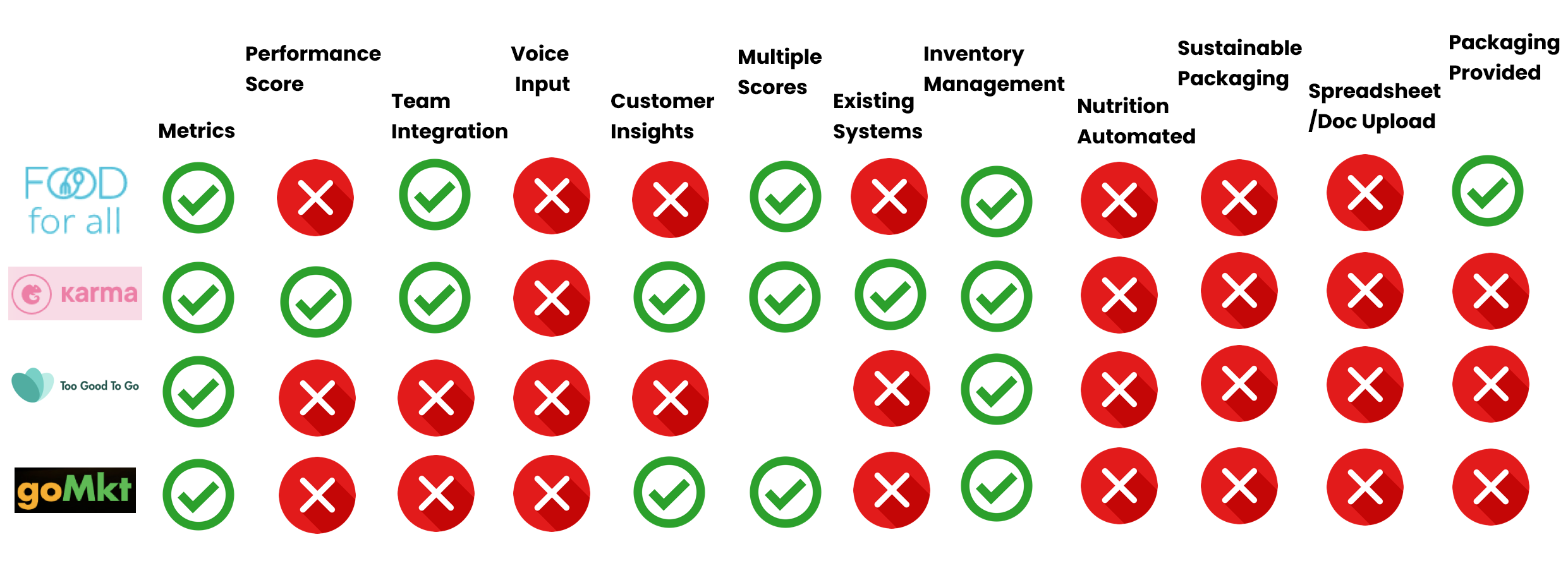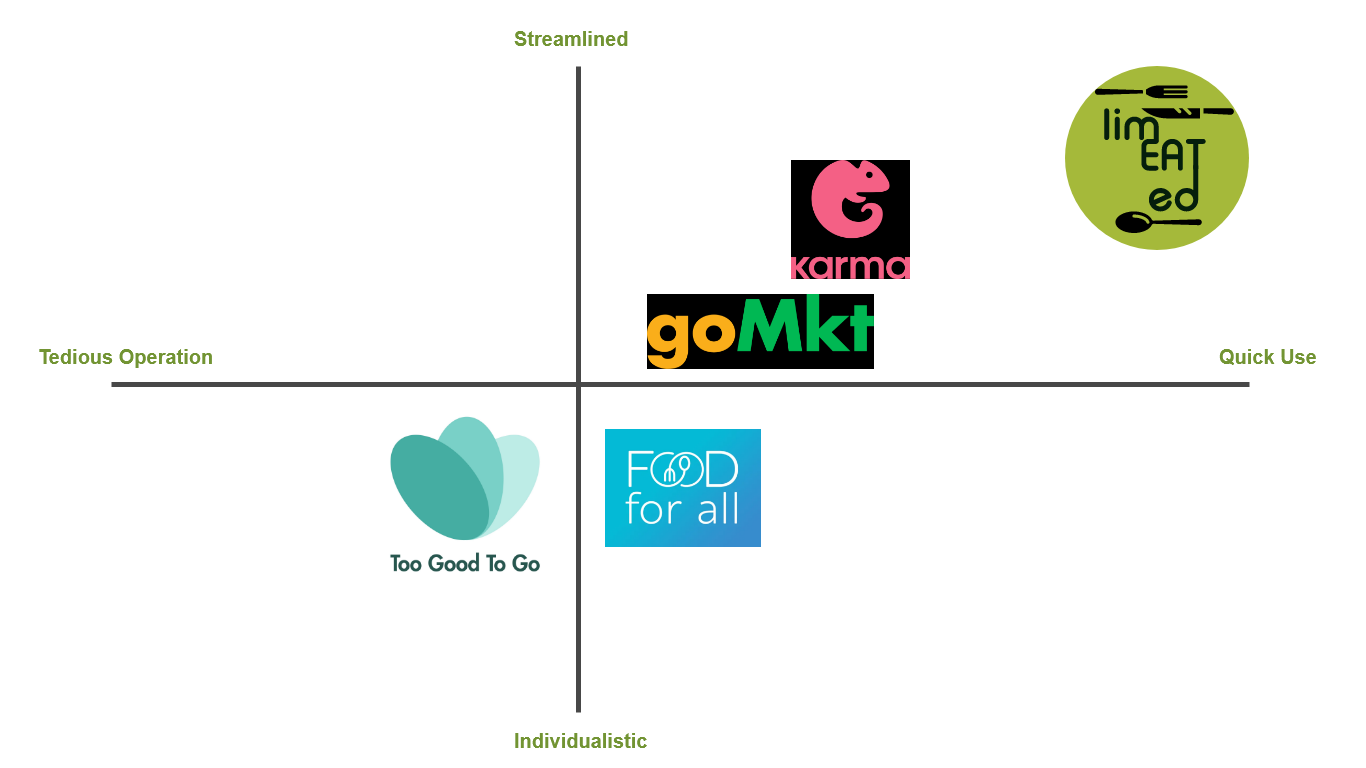LimEated Mobile App
Great food without waste.



LimEated's goal is to reduce food waste on the part of business owners and reduce food insecurity among consumers. The app features step-by-step on-boarding, inventory management, scheduled sales times for extra food on hand and more! LimEated aims to reduce food insecurity in South Florida, which recently rose to roughly 10 percent in Miami.
Goal: Design and deliver LimEated's Business app prototype alongside my partner who was tasked to design the customer app.


Here I chose the two axis streamlined vs Individual and tedious vs quick use. The two axis were picked with the feature gaps from the feature analysis in mind. You can see where LimEated hopes to exist in the market. We hope to reach the goal of being quick to use along with a uniform experience throughout each business.

Most users are located in suburban and urban areas

49% of users are concerned with price. So, keeping extra labor to a minimum to sell the extra food at an affordable price is essential.
"The app does not alert the customer that we ran out of that meal."
"Make it easier for restaurants to sign up."

50% of places I have bought from give half portions to match the half prices!"
"Turned up, no food left and still no refund."
Affinity mapping is one of my favorite parts about the UX process! Here is all the data gathered in the survey and the five interviews. I learned a great deal from grouping similar subjects in the data.
First, I learned that the existing competitors lacked communication between the customer and the business. Many customers would show up to the business after purchasing "at risk" meals and would arrive to find out the business is already sold out. The miscommunication between user and business creates an interaction that lacks trust, and reflects poorly on the business and the food recovery app. But, it also creates an opportunity for design on this product.
Second, I learned about the lengthy on-boarding process for businesses to begin using food recovery apps. Manually inputting entire menus can certainly become tedious.

Value Proposition Canvas is one of the most effective tools to use in understanding the user's mental models. You can see the user's, or in this case, restaurant owner's pains, gains and most importantly customer jobs. The user hires our product to fulfill their customer jobs. By looking at our user's pains and gains we can get an idea of their reasons for hiring our product. They hire LimEated to have a seamless sales process (pain from the hassle of refunds), reduce loss from food waste (gain of an extra income stream) and to gain Eco friendly branding.

Its exciting to see the discoveries coming alive in a user persona. Business Bob is a combination of research gathered through mixed methods, a survey, secondary research and interviews which included restaurant managers and employees. The latter was key in gathering reliable information on day to day operation of food recovery or food waste apps, for example the quote featured in the User Persona came from Giselle, a manager for Dr. Smood in Miami.

Here Business Bob goes through the journey of on-boarding the business then his first sale on a current market food waste app. As you can see in the Journey Map, he does not leave satisfied. In fact, this type of negative experience can lead to a high churn rate among users. The User Journey Map helps immensely in spotting opportunities in design thanks to the exercise of inferring the user's emotions based on the information gathered. Once again using a different lens to spot pains in our user's experience.
Here specifically, there were three majors opportunities for design, speed up and ease on-boarding, streamline the sales process and increase business-customer communication.



I initially ideated with my partner that was tasked with designing the customer app. Using sticky notes for ideation along with a partner or anyone else for that matter is not only fun but deeply insightful. Different perspectives of the same problems is key in this stage and leads to fun and helpful solutions.

The MoSCoW Method is a very strong tool to prioritize your ideation. The top layer of the chart shows the features that are most aligned with out HMW statements and should be the first features implemented in user testing.

Change Taxonomy in the tool bar and user flow.



Add more engaging and interactive on-boarding walking the user through set up and first sale.





I ran 4 tests on the mood-board to see what keywords were used to describe it and if it correlated with LimEated's core values. The results are show below...
- Health, Community, Environment, Joy, Wellness
- Young, Healthy, Nutrition, Nature, Rustic, Friendship
- Community, Unity, Happiness, Adventure
- Green, Cooperative, Healthy, Fun.


Building a small design system is a huge help in rapid prototyping. The Style Tile and Atomic Design are both phenomenal tools to speed up the workflow and to create consistency on teams.






